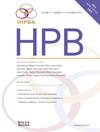Impact of post-hepatectomy liver failure on recurrence following major hepatectomy for colorectal cancer liver metastases
IF 2.4
3区 医学
Q2 GASTROENTEROLOGY & HEPATOLOGY
引用次数: 0
Abstract
Background
Limited research exists on whether post-hepatectomy liver failure (PHLF) impacts recurrence following major hepatectomy for colorectal cancer liver metastases (CRLM). This retrospective study aims to explore this further.
Methods
Data from patients who underwent major hepatectomy for CRLM at Karolinska University Hospital, Sweden, between 2012 and 2020 was analyzed. PHLF definition followed the International Study Group of Liver Surgery criteria. Recurrence risks were estimated with cumulative incidence functions, and Gray's test compared groups. Liver-specific and overall recurrence-free survival (RFS) were assessed using the Fine & Gray subdistribution hazards model, considering competing risks.
Results
Of 327 patients, 11 % developed PHLF grade A and 8 % developed PHLF grade B/C. Liver metastasis recurred in 57 % after a median follow-up of 40 months. Three-year cumulative incidences of liver recurrence was not significantly different: no PHLF (56 %), PHLF grade A (50 %), and PHLF grade B/C (48 %). Respectively for overall recurrence: no PHLF (75 %), PHLF grade A (63 %), and PHLF grade B/C (76 %). PHLF did not significantly impact either liver-specific RFS or overall RFS in multivariable analyses.
Conclusion
Despite its substantial effect on short-term outcomes, PHLF does not appear to be a critical factor for disease recurrence after major hepatectomy for CRLM.
肝切除术后肝功能衰竭对大肠癌肝转移术后复发的影响。
背景:关于肝切除术后肝功能衰竭(PHLF)是否影响大肠癌肝转移(CRLM)术后复发的研究有限。本回顾性研究旨在进一步探讨这一问题。方法:分析2012年至2020年在瑞典卡罗林斯卡大学医院接受肝切除术的CRLM患者的数据。PHLF的定义遵循国际肝脏外科研究小组的标准。用累积发生率函数估计复发风险,用Gray检验比较各组。考虑竞争风险,使用Fine & Gray亚分布风险模型评估肝脏特异性和总体无复发生存率(RFS)。结果:在327例患者中,11%发展为PHLF A级,8%发展为PHLF B/C级。中位随访40个月后,57%的肝转移复发。3年累积肝脏复发率无显著差异:无PHLF (56%), PHLF A级(50%),PHLF B/C级(48%)。总体复发:无PHLF (75%), PHLF A级(63%),PHLF B/C级(76%)。在多变量分析中,PHLF对肝脏特异性RFS或总体RFS均无显著影响。结论:尽管PHLF对短期预后有重大影响,但它似乎不是CRLM大肝切除术后疾病复发的关键因素。
本文章由计算机程序翻译,如有差异,请以英文原文为准。
求助全文
约1分钟内获得全文
求助全文
来源期刊

Hpb
GASTROENTEROLOGY & HEPATOLOGY-SURGERY
CiteScore
5.60
自引率
3.40%
发文量
244
审稿时长
57 days
期刊介绍:
HPB is an international forum for clinical, scientific and educational communication.
Twelve issues a year bring the reader leading articles, expert reviews, original articles, images, editorials, and reader correspondence encompassing all aspects of benign and malignant hepatobiliary disease and its management. HPB features relevant aspects of clinical and translational research and practice.
Specific areas of interest include HPB diseases encountered globally by clinical practitioners in this specialist field of gastrointestinal surgery. The journal addresses the challenges faced in the management of cancer involving the liver, biliary system and pancreas. While surgical oncology represents a large part of HPB practice, submission of manuscripts relating to liver and pancreas transplantation, the treatment of benign conditions such as acute and chronic pancreatitis, and those relating to hepatobiliary infection and inflammation are also welcomed. There will be a focus on developing a multidisciplinary approach to diagnosis and treatment with endoscopic and laparoscopic approaches, radiological interventions and surgical techniques being strongly represented. HPB welcomes submission of manuscripts in all these areas and in scientific focused research that has clear clinical relevance to HPB surgical practice.
HPB aims to help its readers - surgeons, physicians, radiologists and basic scientists - to develop their knowledge and practice. HPB will be of interest to specialists involved in the management of hepatobiliary and pancreatic disease however will also inform those working in related fields.
Abstracted and Indexed in:
MEDLINE®
EMBASE
PubMed
Science Citation Index Expanded
Academic Search (EBSCO)
HPB is owned by the International Hepato-Pancreato-Biliary Association (IHPBA) and is also the official Journal of the American Hepato-Pancreato-Biliary Association (AHPBA), the Asian-Pacific Hepato Pancreatic Biliary Association (A-PHPBA) and the European-African Hepato-Pancreatic Biliary Association (E-AHPBA).
 求助内容:
求助内容: 应助结果提醒方式:
应助结果提醒方式:


